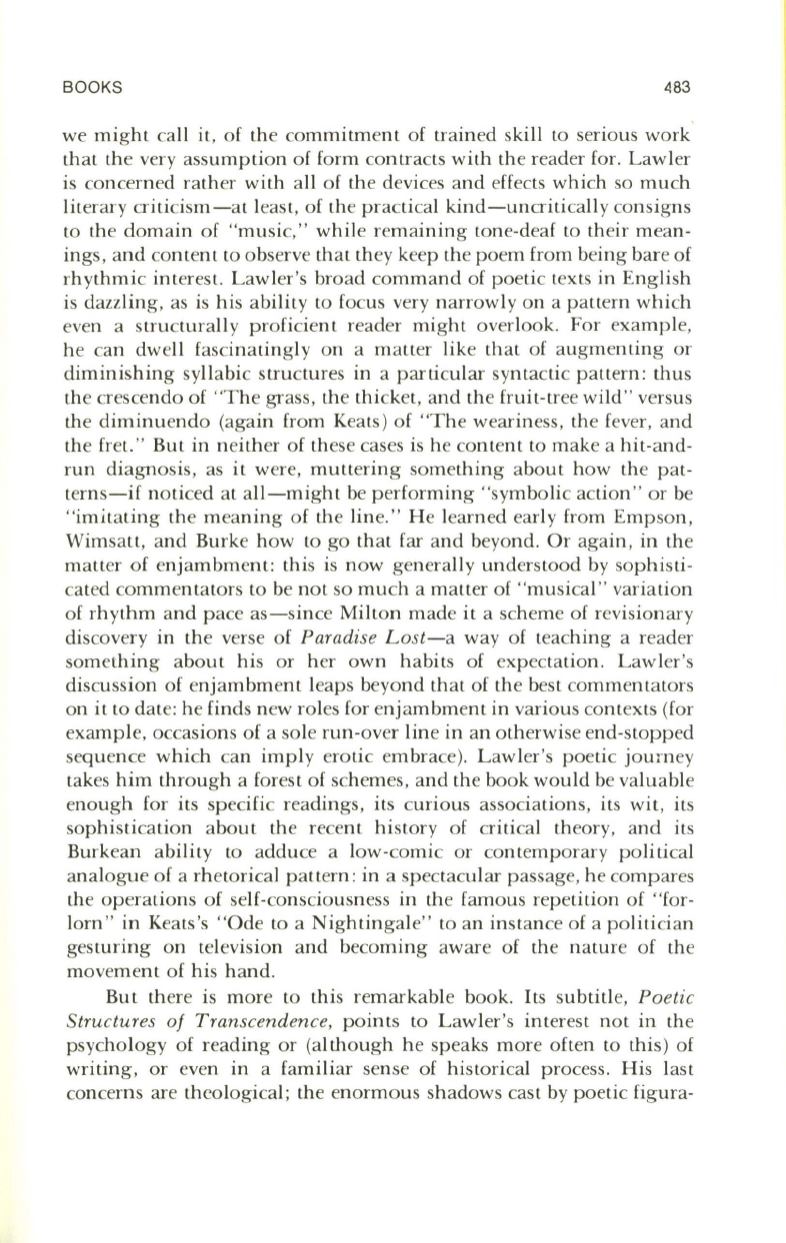
BOOKS
483
we might call it, of the commitment of trained skill
to
serious work
that the very assumption of form contracts with the reader for. Lawler
is concerned rather with all of the devices and effects which so much
literary criticism-at least, of the practical kind-uncritically consigns
to the domain of "music," while remaining tone-deaf to their mean–
ings , and content to observe that they keep the poem from being bare of
rhythmic interest. Lawler's broad command of poetic texts in English
is dazzling, as is his ability to focus very narrowly on a pattern which
even a structurall y proficien t reader might overlook. For example,
he can dwell fascinatingly on a matter like that of augmenting or
diminishing syllabic structures in a particular syntactic pattern: thus
the crescendo of "The grass, the thicket, and the fruit-tree wild" versus
the diminuendo (again from Keats) of ''The weariness, the fever , and
the fret. " But in neither of these cases is he content to make a hit-and–
run diagnosis, as it were, muttering something about how the pat–
terns-if noticed at all-might be performing "symbolic action " or be
"imitating the meaning of the line." He learned early from Empson,
Wimsatt, and Burke how to go that far and beyond. Or again, in the
maller of enjambment: this is now generally understood by sophisti–
cated commentators to be not so much a matter of "musical " variation
of rhythm and pace as-since Milton made it a scheme of revisionary
discovery in the verse of
Paradise Lost-a
way of teaching a reader
something about his or her own habits of expectation. Lawler's
discussion of enjambment leaps beyond that of the best commentators
on it to date: he finds new roles for enjambment in various contexts (for
example, occasions of a sole run-over line in an otherwise end-stopped
sequence which can imply erotic embrace). Lawler 's poetic journey
takes him through a forest of schemes, and the book would be valuable
enough for its specific readings, its curious associations, its wit, its
sophistication about the recent history of critical theory, and its
Burkean ability to adduce a low-comic or contemporary political
analogue of a rhetorical pattern : in a spectacular passage, he compares
the operations of self-consciousness in the famous repetition of "for–
lorn " in Keats's "Ode to a Nightingale" to an instance of a politician
gesturing on television and becoming aware of the nature of the
movement of his hand.
But there is more to this remarkable book. Its subtitle,
Poetic
Structures of Transcendence,
points to Lawler's interest not in the
psychology of reading or (although he speaks more often to this) of
writing, or even in a familiar sense of historical process. His last
concerns are theological; the enormous shadows cast by poetic figura-


